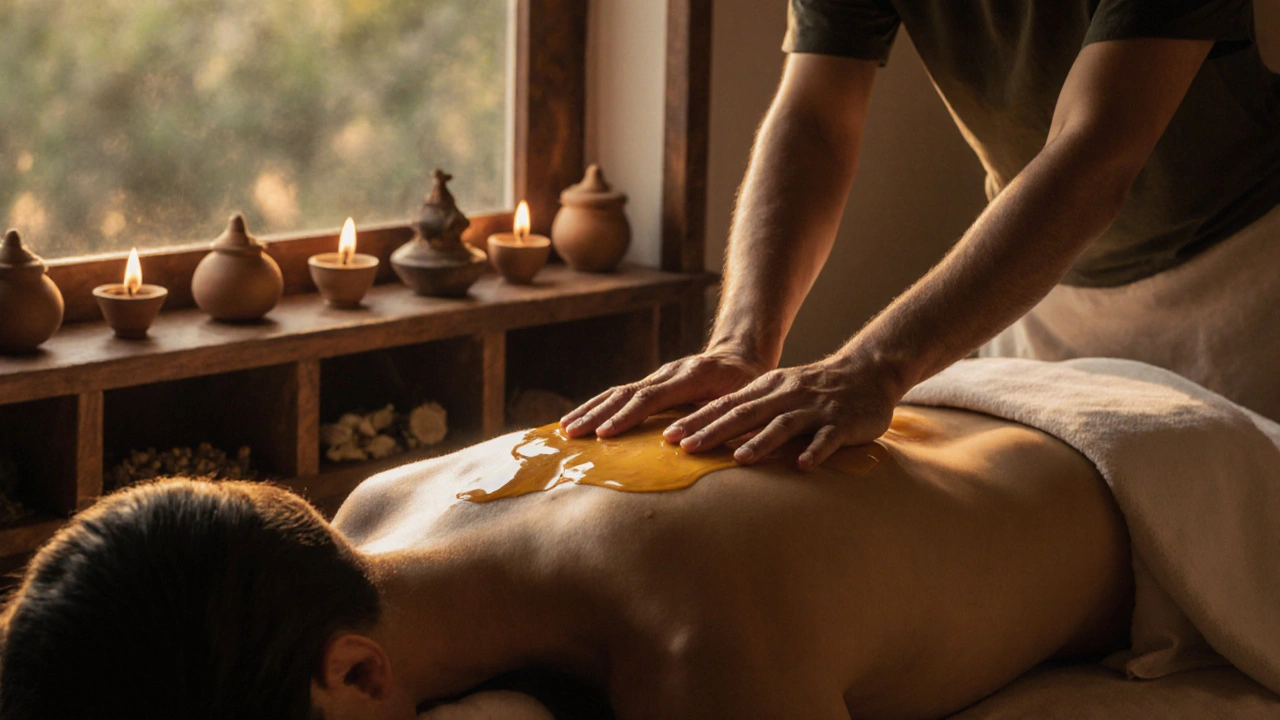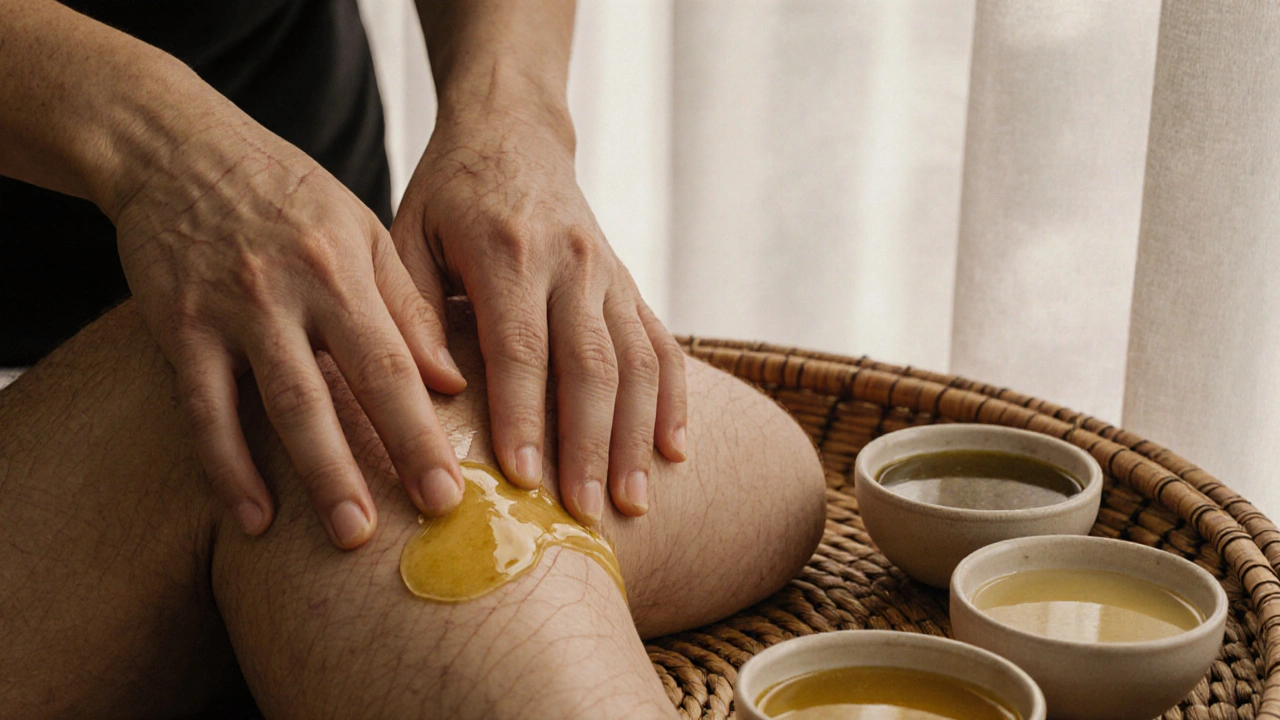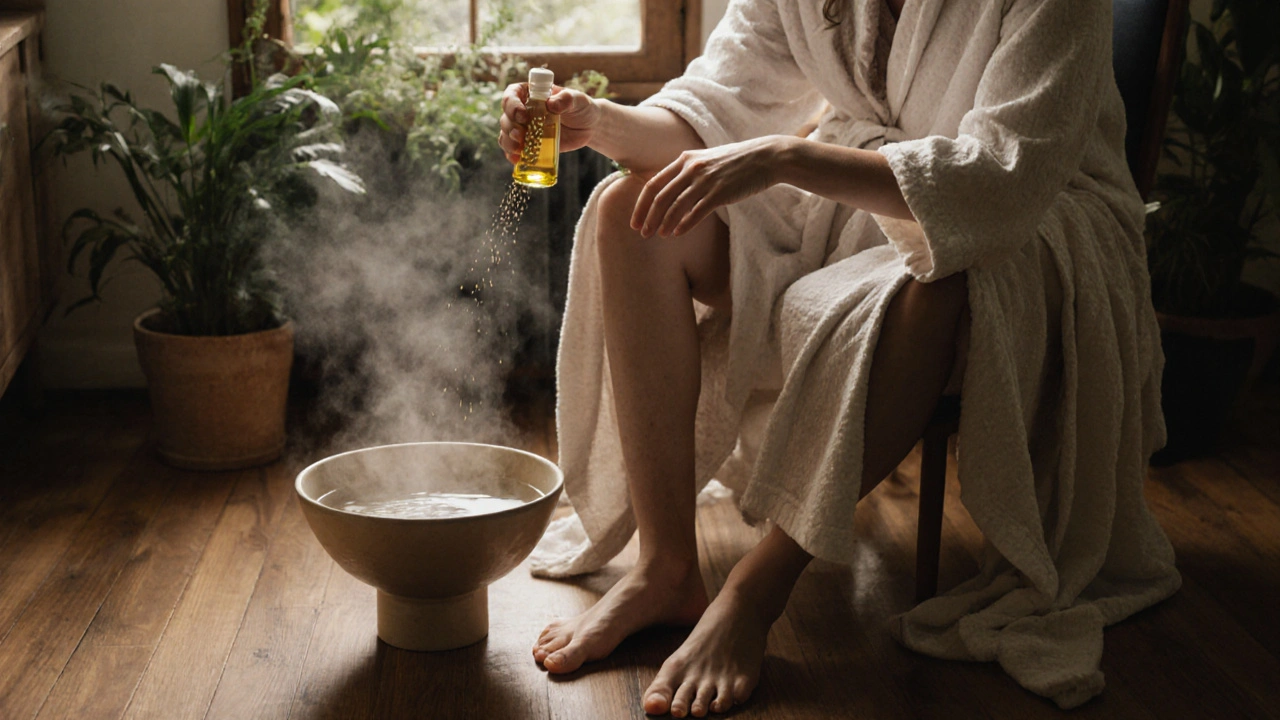Ayurvedic Massage: A Natural Path to Better Health
 Nov, 2 2025
Nov, 2 2025
Ayurvedic Dosha Calculator
Discover Your Ayurvedic Body Type
This assessment helps determine your dominant dosha (Vata, Pitta, or Kapha) to guide your Ayurvedic massage practice.
Most people think massage is just about relaxation. But if you’ve ever tried an ayurvedic massage, you know it’s something deeper. It doesn’t just loosen tight muscles-it rewires how your body feels day to day. This isn’t a spa treat. It’s a 5,000-year-old system from India designed to bring your whole being back into balance. And it works-not because of fancy oils or exotic chants, but because it’s built on real science of the body.
What Exactly Is Ayurvedic Massage?
Ayurvedic massage, often called abhyanga, isn’t one technique. It’s a ritual. The word comes from Sanskrit: abhyanga means "to rub with oil." But the oil is just the start. The real magic is in how it’s done-slow, rhythmic strokes that follow energy pathways in the body called marma points. These aren’t random spots. They’re junctions where nerves, blood vessels, tendons, and bones meet. Pressing them correctly can shift how your nervous system reacts to stress, improve circulation, and even help digestion.
Unlike Swedish or deep tissue massage, ayurvedic massage doesn’t target pain alone. It targets your dosha. That’s the Ayurvedic term for your body’s unique energy type: Vata, Pitta, or Kapha. Most people don’t know they have a dominant dosha, but it shows up in how you sleep, how you handle stress, even what foods make you feel bloated. A good ayurvedic therapist doesn’t just massage you-they ask you questions first. Are you always cold? Do you feel scattered? Do you hold tension in your jaw? Those clues tell them which oils and motions will help you most.
How It Works: Oil, Motion, and Energy
The oils used aren’t picked randomly. Sesame oil is warm and grounding-perfect for Vata types who feel anxious or dry. Coconut oil is cooling and calming-ideal for Pitta people who get fiery tempers or rashes. And for Kapha types who feel sluggish, mustard or sunflower oil brings lightness and movement. These aren’t just carrier oils. They’re medicine.
The massage itself moves in circular patterns around joints and long strokes along limbs. This isn’t arbitrary. It follows the direction of lymph flow and the body’s natural rhythms. In Ayurveda, the body is seen as a river. Blockages? That’s where illness starts. The oil softens toxins (called ama) stuck in tissues. The motion helps flush them out through the skin and lymphatic system. Studies from the National Center for Complementary and Integrative Health show that regular abhyanga improves skin hydration, reduces cortisol (the stress hormone), and even lowers blood pressure over time.
And here’s the part most people miss: it’s not just the massage that matters. It’s the ritual. Warming the oil before applying it. Doing it in the morning before your shower. Silence. No phone. Just breath and touch. That’s what turns a bodywork session into a reset button for your nervous system.
What You’ll Feel After Your First Session
After your first ayurvedic massage, you might not feel like you’ve had a "workout." But you’ll feel different. Lighter. Quieter inside. That’s because the massage doesn’t just relax muscles-it calms the mind’s chatter. Many people report sleeping deeper the next night. Others say their digestion improves within a day. One woman in Melbourne, who’d struggled with chronic bloating for years, told me she noticed her stomach felt flat for the first time in a decade after just three sessions.
It’s not magic. It’s physiology. The pressure on marma points stimulates the vagus nerve-the main nerve connecting your brain to your gut, heart, and lungs. When that nerve fires properly, your body switches from "fight or flight" to "rest and digest." That’s why people with anxiety, insomnia, or IBS often see results faster than those with muscle pain.
Don’t expect instant miracles. But if you do it once a week for a month, you’ll notice changes you didn’t know you needed. Your skin glows. Your joints move easier. You stop reaching for caffeine after lunch. That’s the dosha balance talking.

Who Should Try It-and Who Should Skip It
Ayurvedic massage is safe for most people. But it’s not for everyone.
- Do try it if you feel constantly tired, stressed, or out of sync with your body.
- Do try it if you have dry skin, stiff joints, or trouble sleeping.
- Do try it if you’re open to slow, intentional care-not quick fixes.
Avoid it if you have:
- Open wounds, recent surgery, or active infections
- Severe varicose veins or blood clots
- High fever or acute inflammation
- Are pregnant without prior consultation (some oils aren’t safe)
And if you’re allergic to sesame, coconut, or mustard oil-ask your therapist to swap them. Many clinics now use almond or jojoba oil as alternatives.
How to Find a Real Ayurvedic Practitioner
Not every "ayurvedic massage" is authentic. Some spas slap on coconut oil and call it ayurvedic. That’s like calling a latte "espresso."
Look for these signs:
- They ask about your sleep, digestion, and stress levels before the session
- They use warm, organic oils-not cheap, synthetic ones
- They don’t rush. Sessions last 60 to 90 minutes
- They mention doshas and marma points by name
- They’re certified by an Ayurvedic school, not just a weekend course
In Melbourne, clinics like AyurVeda Wellness Centre and The Ayurvedic Room train therapists in traditional Indian lineages. Ask if they studied under a registered Ayurvedic doctor (Vaidya). That’s the gold standard.

Can You Do It at Home?
Yes. And you should.
Even 10 minutes of self-massage-abhyanga for yourself-makes a difference. Warm a tablespoon of sesame oil (or whatever suits your dosha). Rub it into your scalp, then down your arms, legs, and abdomen. Use circular motions on joints, long strokes on limbs. Do it before your morning shower. Let the oil soak in for 10 minutes, then rinse with warm water.
It’s not about perfection. It’s about consistency. People who do this five times a week report better moods, less joint stiffness, and deeper sleep. No expensive tools. No apps. Just oil, your hands, and five minutes of quiet.
Why This Isn’t Just Another Trend
Ayurvedic massage isn’t trendy. It’s timeless. While modern wellness fads come and go-cryotherapy, infrared saunas, CBD oils-this has survived because it works at the root. It doesn’t mask symptoms. It helps your body remember how to heal itself.
It’s not about being "spiritual." It’s about biology. Your body has always known how to balance itself. You just forgot how to listen. Ayurvedic massage teaches you to listen again.
Try it for four weeks. Not because it’s "in style." But because you deserve to feel calm, grounded, and truly at home in your own skin.
Is ayurvedic massage painful?
No, it shouldn’t be. Ayurvedic massage uses firm but gentle pressure, never sharp or aggressive. If you feel pain, speak up. The goal is relaxation, not bruising. Some areas might feel tender if there’s tension or toxins built up, but discomfort should ease as the oil and rhythm work.
How often should I get an ayurvedic massage?
For general wellness, once a week is ideal. If you’re managing stress, insomnia, or chronic pain, twice a week for the first month helps reset your system. After that, once every two weeks maintains balance. Even monthly sessions offer benefits if you’re consistent with self-massage at home.
What’s the difference between ayurvedic massage and Thai massage?
Thai massage uses stretching, compression, and acupressure along energy lines, often done on a mat with the client fully clothed. Ayurvedic massage focuses on oil, slow rhythmic strokes, and marma points, usually done on a table with the client unclothed under a sheet. Thai massage is more dynamic; ayurvedic is more soothing and internal.
Can ayurvedic massage help with arthritis?
Yes, especially for osteoarthritis. The warming oils improve circulation to stiff joints, and the gentle pressure reduces inflammation over time. A 2022 study in the Journal of Ayurveda and Integrative Medicine showed participants with knee osteoarthritis had reduced pain and improved mobility after 8 weeks of weekly abhyanga. It’s not a cure, but it’s one of the safest, non-drug ways to manage symptoms.
Do I need to follow an ayurvedic diet too?
Not to benefit from the massage. But if you want deeper, lasting results, yes. Ayurveda sees body and mind as connected. Eating foods that match your dosha-like warm, cooked meals for Vata, cooling foods for Pitta-supports what the massage does. You don’t need to become vegan or give up coffee. Just notice how certain foods make you feel. That’s the first step.
